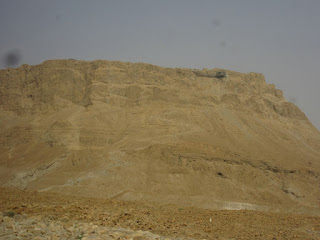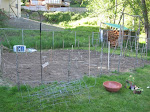The ruins of the mountain-top fortress of Masada are spectacular, but in light of its tragic story they also become a powerful place to visit. Up until 1986, all IDF soldiers climbed the Snake Path up the 900 feet to the top and swear an oath of "Masada shall not fall again."
the hike up the path takes about 45 minutes to an hour
As we approached the park, we noticed people camped out by the entrance. That would be fun!
In order to keep on schedule, we took the cable car up...
Built during the time of the Maccabees, it was built up and fortified by Herod the Great in case of a Jewish rebellion or if Cleopatra of Egypt should try to kill him.
The attention to detail here was amazing! Walls were painted with brightly colored frescoes. Floors were elaborately tiled. Stones were carved with beautiful designs.
didn't see many triangular tiles
popular floor tile design from the period
dovecotes were built to raise doves for eating and sacrifices
at the synagogue
1st century synagogue
Byzantine monks later built a church on the site and lived there.
Herod's ceremonial and administrative palace had a swimming pool as well as bathhouses. One bathhouse included a raised floor that was heated by furnaces forcing hot water through pipes.
the furnaces from the inside
the furnaces from the outside where the fire was lit
Herod had his residential three-tiered palace carved into the north point, connected by stairs. Amazingly, he never lived there.
Long narrow storehouses were built to have enough food to last through a siege of 3 1/2 years. Wine sent to Herod from Italy were found here.
Large cisterns were dug at both the bottom and top of Masada. Water was channeled from nearby wadis to the lower cisterns and then carried up the mountain to deep water cisterns.
All this served the Jewish zealots, the Sicarri, well when they conquered the Roman garrison at Masada in about 66-68 AD. After the Roman destruction of Jerusalem in 70AD, Lucius Flavius Silva and the 9000 men of 10th Legion turned their attention to the Jewish rebels there.
You can still see the ruins of the 8 Roman camps surrounding the mountain connected by a wall, 7 miles long and six feet thick to prevent escape.
Then the Romans built a 350 foot high ramp to raise a siege tower up to breach the gates. Using Jewish slave labor, they knew the Sicarii would not kill them and stop the work.
rocks stored to use against enemy attacks
When the Romans reached the gates and set them on fire, the winds changed and turned the flames back onto the Romans. Silva decided to wait to breach the fortress in the morning.
The Jewish leader, Eleazer ben Ya'ir, saw it as a sign from God. He gave an impassioned speech, convincing the people to kill themselves rather than be taken as Roman slaves. Lots were written on pieces of pottery and drawn to decide the 11 men who would kill the others. One of those men was chosen to then kill himself, a grievous sin for the Jews.
“it is still an eligible thing to die after a glorious manner, together with our dearest friends . . . let us bestow that glorious benefit upon one another mutually, and preserve ourselves in freedom, as an excellent funeral monument for us”.
the site where the pieces of pottery used as lots were found
When the Romans arrived in the morning, they found the bodies of 960 men, women and children. Only 2 women and a few children survived by hiding in a cistern.
It was another very hot day when we were there, so many people went back down to the visitor's center. Greg said there was time for a few of us to go and see Herod's palace on the north end OR the large cistern on the southern end but not both. We took that as a challenge we were ready to accept. Before the words were out of his mouth, we were off.
First we went to the palace...
Then we made a mad dash for the cistern...
It was totally worth it! And we even had time to get an ice cream before meeting back up at the entrance.





















































No comments:
Post a Comment